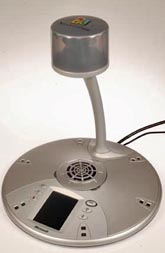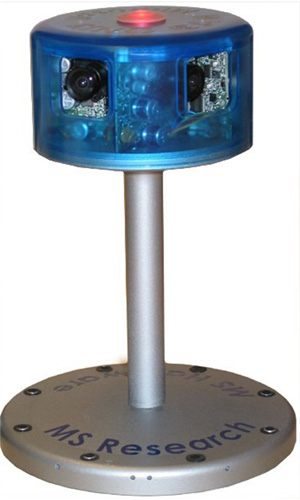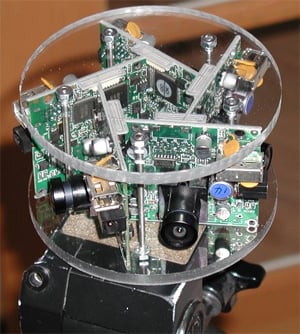Monday, June 25, 2007
Microsoft Office RoundTable Review
 Microsoft Office RoundTable is a very cool videoconferencing system featuring 360° panoramic views powered by its 5 built-in cameras. Microsoft sent me a RoundTable system for review. I figured I may as well install it in one of TMC's two conference rooms to have some "real world" testing scenarios. After plugging in the various cables, including a USB cable to the host PC, I then installed the Microsoft Office Live Meeting 2007 (LM 2007) beta software client, which was designed to handle the RoundTable's 360° panoramic cameras. I should point out that Microsoft is offering both a hosted model for Microsoft Office Live Meeting 2007 as well as a CPE (customer premise equipment) solution, namely Office Communications Server 2007 (OCS 2007). The RoundTable can work with either. However, I tested it with a Microsoft Office Live Meeting online beta account.
Microsoft Office RoundTable is a very cool videoconferencing system featuring 360° panoramic views powered by its 5 built-in cameras. Microsoft sent me a RoundTable system for review. I figured I may as well install it in one of TMC's two conference rooms to have some "real world" testing scenarios. After plugging in the various cables, including a USB cable to the host PC, I then installed the Microsoft Office Live Meeting 2007 (LM 2007) beta software client, which was designed to handle the RoundTable's 360° panoramic cameras. I should point out that Microsoft is offering both a hosted model for Microsoft Office Live Meeting 2007 as well as a CPE (customer premise equipment) solution, namely Office Communications Server 2007 (OCS 2007). The RoundTable can work with either. However, I tested it with a Microsoft Office Live Meeting online beta account.The RoundTable actually installs two USB camera devices. The first is the Active Speaker which uses the RoundTable's 6 microphones to locate where in the room the active speaker is and then focus one of the 5 cameras onto that person. I suspect it may actually use 2 cameras to focus on a person, since it always appears that the speaker is "centered" which probably would require at least 2 camera images and then the images are "spliced" together, processed, and then transmitted over the USB cable. The second USB camera device is the panoramic camera which combines the 5 camera images into a single panoramic image.
Next, I initiated a Live Meeting session in the conference room and went back to my desk to join the meeting. Unbeknownst to me, by the time I got to my desk, some TMC sales team members walked into the conference room to start a meeting. When I launched my LM 2007 client I saw Anthony Graffeo, one of TMC's sales staff staring right into one of the 5 triangular mirrors located just above the cameras. I headed over the conference room to tell them I could see and hear everything that was going on. After giving a brief demo, Anthony said, "that frickin thing is awesome!". I heard similar comments from other TMCers over the next few days - including "That thing is cool" and "Wow! What is that?"

During my tests with Office Live Meeting 2007, I was able to see the entire conference room in the panoramic view. The other video view is the "active speaker" and it would change to whoever was speaking. It was actually quite accurate and surprisingly fast. When I tested it with Rich Tehrani, Joe Fabiano, Mike Genaro, and Dave Rodriguez, we all took turns speaking and the camera view would almost instantly switch.
Overall, the video quality was excellent, Very smooth. Later on I did some more tests with just me in the conference room. I tried to trick the cameras by snapping my fingers above the microphone and the video wouldn't switch. I figured it must be using a combination of audio and video cues to determine the active speaker. A quick glance in the manual reveals, "To avoid switching to a non-human sound source, the video functions to assist in determining whether the sound detected is coming from an attendee or some other source." Answers that question!
Below is a Flash demo demonstrating the active speaker functionality. When I ran this test, I did it by myself and just walked around the conference room while continuing to speak. I will make a 2nd video with several fellow TMCers if I can get some volunteers. This would better demonstrate the active speaker feature. Also, the video I did record appears much jerkier than it actually was live. Part of that is because it was my first time using Camtasia Studio to capture the screen & audio, so I only had it set to 15fps (not 30fps). Secondly, the PC I was recording on isn't the greatest, so I'm sure Camtasia skipped a few video frames since it the processor was taxed. Nevertheless, this video gives you a good feel for the active speaker functionality. If you want a larger-resolution version, click here.
The base has an LCD touch-screen that serves as a dialpad and to configure various options. An external dialpad is available as well, but I didn't get one with my unit, so not sure if that's an extra option. The LCD touch-screen dialpad seems good enough to me. Physical buttons also exist to increase/decrease speaker volume, a mute audio / halt video button, Flash button, on/off hook, and an Information button. There is also a privacy cap that goes on top of the unit to block the cameras and prevent anyone from viewing the conference room.
Although the Microsoft RoundTable was designed for Office Live Meeting 2007 & OCS 2007, since it is simply 2 separate USB camera devices in the Device Manager, I figured it would most likely work with other videoconferencing, audioconferencing, or VoIP software. So I fired up Skype on the conference room PC and went into the video wizard. I tried the panoramic device first, but all that was displayed was a black screen. Then I changed it to the active speaker USB camera device and it worked. I made a test Skype call to the Microsoft Roundtable, again with some fellow TMC'ers and the active speaker functionality worked just as well in Skype. Obviously, it's the RoundTable hardware performing the video switching and not LM 2007. Also, I was able to use Skype's "full screen" video mode and it had extremely high-resolution video with very fast frame rates. Here's a screenshot of Skype in action viewing the RoundTable video:

Microsoft designed RoundTable to equalize the varying light levels when one part of the conference room is darker than another. In fact, TMC's conference room has sunlight coming in the window and I noticed the RoundTable was able to do a pretty good job equalizing the light across the entire room.
The Microsoft RoundTable features both an RJ11 (phone) and an RJ45 (network) jack. The RJ11 wire lets you connect to a PSTN line and use the RoundTable as a high-end conference room speakerphone. The RoundTable lets you place outgoing calls, answer an incoming call, conduct a video conference with audio from the microphones or a video-only session with no audio from the microphones. In the video-only mode you can use the PSTN line or even your cell phone for the audio portion.
I like the aesthetic design of the Microsoft RoundTable. It is one cool looking device. Reminds me of the alien spaceships in H.G. Wells' War of the Worlds movie (the original 1953 movie, not the Tom Cruise remake). Compare for yourself! Both have "eyes" and both have a long neck connected to the main base.


Interestingly, the RoundTable doesn't aim its 5 cameras directly at you. As previously mentioned, it uses triangular mirrors. I'm not sure if this was done because people are more relaxed and natural if they don't think a camera is staring right back at them or if it was simply for aesthetic design that Microsoft chose to use mirrors. I did some research on the history of the RoundTable and discovered it was previously called the Ringcam. During Microsoft's research, they had some interesting "beta" versions before the final RoundTable, including these two below. Note how both models point cameras directly outward. I definitely prefer the less obtrusive "mirror" version in the production model. I tried to take apart the RoundTable to see the inner guts of the camera head, but the damn thing is glued on or something since I couldn't find any screws.


Even more interesting in a Microsoft Research PDF article it talks about head-size spatial equalization. That is, making sure everyone's head is equally big in the videoconference even if a person is further from the camera. The article has several diagrams and complex trigonometry formulas (sin & cos functions) that bring back high school. The article states the following:
In the past a few years, there has been a lot of interest in the use of omni-directional cameras for video conferencing and meeting recording. While a panoramic view is capable of capturing every participant’s face, one drawback is that the image sizes of the people around the meeting table are not uniform in size due to the varying distances to the camera. Figure 1 shows a 360 degree panorama image of a meeting room. The table size is 10x5 feet. The person in the middle of the image appears very small compared to the other two people because he is further away from the camera.
This has two consequences. First, it is difficult for the remote participants to see some faces, thus negatively affecting the video conferencing experience. Second, it is a waste of the screen space and network bandwidth because a lot of the pixels are used on the background instead of on the meeting participants. As image sensor technology rapidly advances, it is possible to design inexpensive high-resolution (more than 2000 horizontal pixels) omni-directional video cameras [1]. But due to network bandwidth and user’s screen space, only a smaller-sized image can be sent to the clients. Therefore how to effectively use the pixels has become a critical problem in improving the video conferencing experience.
Spatially-varying-uniform (SVU) scaling functions have been proposed [2] to address this problem. A SVU scaling function warps a panorama image to equalize people’s head sizes without creating discontinuities. Fig. 2 shows the result after head-size equalization.
Note how the guy in the white shirt is larger after head-size equalization. Unfortunately, it doesn't appear that the RoundTable I'm testing incorporates the head-size equalization, since none of the heads in the conference room appeared to be equalized. Guess my head (& ego) will have to continue to be the biggest.
 I read up on this some more and according to this Microsoft article, RoundTable "uses visual cues to pinpoint, enlarge and emphasize the face of the speaker". So it sounds like it does have this feature. I'll have to test this further.
I read up on this some more and according to this Microsoft article, RoundTable "uses visual cues to pinpoint, enlarge and emphasize the face of the speaker". So it sounds like it does have this feature. I'll have to test this further.Conclusion
All in all, I was pretty impressed with the Microsoft RoundTable. With its panoramic view and active speaker video switching functionality, you almost feel as though you are there in the conference room. I do wish the panoramic USB camera device worked in other applications besides LM 2007 and OCS 2007, but at least the active speaker video works. Although not released for general availability, the Microsoft RoundTable is expected to retail for around $3,000 putting this in the category of high-end videoconferencing systems. However, with fuel costs and other travel expenses, a high-quality, high-end videoconferencing system can pay for itself very quickly.
Mobile operators lock VoIP
Edited - Thanks Andy for the heads-up. Much of this content came from the ZDNet article. Cheers David for the scoop.
The mobile cartels are at it again. So soon after the telecoms regulator Ofcom forced a reduction in their termination rates, they are again running scared, this time over phones that enable VoIP.
 Orange and Vodafone today decided to remove VoIP functionality from Nokia’s N95 handset.
Orange and Vodafone today decided to remove VoIP functionality from Nokia’s N95 handset.
The feature-rich Nokia N95 supports SIP, which enables integrated IP telephony capabilities, a service that business users are increasingly demanding. Orange and Vodafone, however, have disabled that feature on their N95 handsets.
A spokesperson for Orange said it was “not Orange’s policy to remove VoIP functionality from devices. This is a handset-specific issue and, in this particular instance, Orange was asked by Nokia whether they wanted the VoIP functionality switched on or off, and Orange selected off”.
Vodafone takes a different view. “Vodafone currently does not offer a VoIP proposition that would allow its customers to have universal access to telephony services. Vodafone believes that VoIP over mobile is not yet a mature service proposition, doesn’t have guaranteed quality of service, and does not provide the customer experience demanded of any service we launch,” a spokesperson for the mobile operator said on Thursday. “There is a misleading perception that VoIP services are ‘free’. This is, however, not the case when it comes to using VoIP over mobile, where customers… may incur further charges.”
It looks to me like the mobile cartels are seeing their house falling down.
The real truth is far more simple. VoIP will enable people to call without the need to go through mobile operators. Not surprising then that they have turned off this feature.
How does this affect Rebtel?
Don’t worry – our service allows you to use your free minutes to call anyone internationally for free.
QIP Infium: Now SIP Inside!

The Russian subscribers have got a real alternative to Skype, one of the most famous internet communication programs. CNews found out, QIP developers finished QIP Infium program creation, integrated with SIPNET Russian telephony operator products and USB equipment for Skypemate voice communication. Besides the multi services messenger (like QIP Infium) the Russian users have got a service, enabling them to communicate with the whole world practically free of charge.
CNews learnt out, QIP Infium messenger beta-version development was finished in June 22, 2007. QIP Infium multi-services program supports ICQ, Jabber and XIMSS (SIP). The presence of the XIMSS module in the new product means that all the QIP Infium users will get the opportunity to communicate through the internet practically free of charge using the mentioned program. QIP Infium provides many new opportunities: the product supports not only numerous services but makes it possible to work with several profiles, plug-ins, unicode, etc.
QIP Infium is integrated with Skypemate hardware. It means that to use the internet telephony, it is necessary to acquire one of the many SkypeMate devices (for example, any USB handset). Then one may simply plug the bought device to the computer or notebook USB-port, and it will automatically attach to QIP Infium. The SIPNET card is already included into all the boxes with the SkypeMate products. The login and password recorded on the card are to be indicated in the XIMSS messenger tuning module.
Thus a user gets the opportunity to phone to any part of the world for token payment. Current Moscow and St. Petersburg connection is carried out absolutely free of charge. Anyone can phone to the user’s computer using a stationary telephone or a handset. It is enough to simply dial a special gate number (each town has its own number), and to dial SIP ID (recorded on the SIPNET card).
According to the developers such a solution has many advantages, form the possibility to significantly reduce telephone conversation expenses to the fact that the user receives an additional full-scale telephone line above all.
“QIP Infium is quite a unique product, - Sergey Kravtsov, Head of the Department on cooperation with SIP equipment suppliers told to the CNews correspondent. - At present it has attracted millions of communication service users both in Russia and abroad. It is just what the market needs, while SIPNET services integration into QIP Infium enables an ordinary internet user to estimate the VoIP advantages in full. We see that the product is rather easy in exploitation, and that is very important. At present it is enough to enter Euroset, Bely Veter, Polyaris or PCHome.ru, buy any SkypeMate USB handset, fill up your personal account, launch your QIP Infium and simply start communicating”.
“The appearance of such a multi-services project like QIP Infium indicates that IP-telephony market has been developing in the right direction, when QIP Infium, SIPNET operator and Skypemate equipment suppliers combine their efforts to achieve one single goal. And our common goal is to make internet communication easier and more popular”, - Mikhail Usov, UMD Project, Means of Radio Communication Joint-Stock company Director General, the exclusive supplier and Skypemate trade mark owner in Russia says.
“There are many difficulties for an ordinary Russian resident to work with new technologies and equipment for such technologies (SIPNET, Skype, etc.), when using hardware to simply start working (registration, filling up the accounts)”, - Vladimir Tyurin, Euroset operators supervision Project Manager says. According to Mr. Tyurin, SkypeMate USB handsets are successfully sold and SIPNET payments are carried out in the Euroset retail outlets. QIP Infium allows people to start operating the sold equipment in short time and that is a great plus. The "switch on and start working” principle might interest many users and that will all ow to make even more people use the new equipment, distributed by our retail outlets”, - Vadim Tyurin thinks.
QIP Infium designers do not intend to stop and plan to add a great number of new possibilities to their product as well as to finish off the already existing products in the near future.
“Infim has combined those advantages that were collected during QIP 2005 creation and testing, - Ilkham Zyulkorneev, the projects author says. – Redesigning a wheel once again one already knows where the hidden problems might appear and tries no to repeat the former mistakes. Most of all we wanted not only to realize the possibility of supporting several profiles and different ways of transferring instant messages in Infium, but also to eliminate all the possible inconveniences and to create such an interface that is practically the same as the usual qip2005. Using Infium, you might now switch to different networks to send instant messages, beginning with Jabber and finishing with Mail.ru agent, everything depends on your desire and choice”.
Developers of Mail.ru Agent - QIP Infium messenger competitor – positively estimate the new product prospects on the market: “I can say that I appreciate QIP designers, who managed to create such an easy product that it has won over the greatest market share of the ICQ original product. I think they will be able to win over a part of Skype users in Russia, but not to replace the mentioned product”, - Anna Artamonova, Mail.ru Marketing Director believes. Finam agrees with Mrs. Artamonova but adds there is practically nothing to win from Skype. “According to our estimates not more than 300 thousand users exploit Skype at present. The market is far from being saturated. Those who are more serious in promoting their products might gain a worthy marketplace rather quickly”.
Download QIP Infium 3,33MbDownload QIP English
Download QIP Deutsch
SIP vs VoIP
So, the consequence is that the blog world on VoIP now is starting to question whether the steam has run out of VoIP. Thomas Anglero blogs about this in Telecom's Tsunami. However, as I wrote to him in a private email:
"I have been looking forward to this. Let the tourists go home and the real innovation begin...
but I didn't write about the basic tenet underlying why I bother: That SIP together with established web-technologies is the missing real-time, two-way communication layer required to move Web 2.0 beyond the mini-apps we see today and towards the web as a real-time network of small web applications communitating and acting on behalf of users. That SIP was used to implement VoIP is good because it gets the traction, but VoIP is just a small piece of what SIP soon will do."
I realized that my comments to Thomas belonged here on the blog. So, all SIP people out there, get started innovating using SIP without VoIP, think sessions, anything that belongs in a session will benefit from SIP!
Jiri Kuthan talked about SLAMP (SER, Linux, Apache, mySQL, Perl/PHP) at the SER developers' meeting in Prague. He may be more right than he thinks. SIP Express Router is well positioned to become the apache of everything that is sessions-based on the Internet. Do you have an Ajax-based web application that needs to subscribe to a user's continously updated contact lists in order to provide that extra functionality? The answer is SIP. Do you want to track a GPS unit's movements? SIP. Do you want to push a map on a user's mobile phone while you are the phone because he calls you and cannot find your offices? SIP again.
So, get started with SLAMP innovation. Create that SER plugin and connect it to your web application. Create SIP user agents that have nothing to do with VoIP. Let us show the tourists that real innovation is on the Internet, not in the old telco world!
Mobile-to-SIP Free Client

Offering free stuff can surely bring you into limelight but if you would like to survive in the long term you need to be highly competitive in order to create a mark. Fring, a company from Israel is out with a mobile phone client which offers free VoIP calls to fixed line VoIP clients such as Skype, GogleTalk and MSN besides user of their technology. The company is using viral marketing as a weapon to create a mark in the VoIP word which is already populated with a number of companies offering free calls.
With a number of companies doling out free stuff I wonder for how long they will be able to sustain it? It seems that in the long term a number of companies would lose steam and only those who have a large user base and attractive rates will stay in the race.

